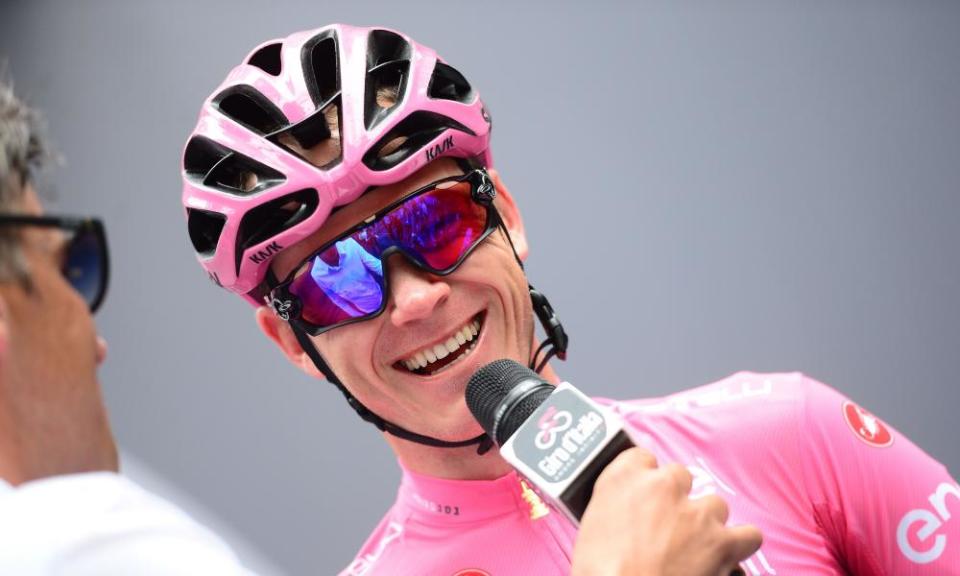Unanswered questions leave Chris Froome in the shadow of suspicion

When Simon Yates cracked so disastrously on the bottom slopes of the Colle delle Finestre while leading the Giro d’Italia last Friday, it looked like the most humiliating of personal catastrophes. Yet it may have been the best thing that has ever happened to the young English rider, at least if he wants to avoid the fate of Chris Froome, the man who caused his downfall.
Yates had gone into his 13th day in the leader’s pink jersey holding an advantage of almost half a minute over his nearest pursuer, with the memory of a trio of majestic victories on mountain stages to keep his morale high as he faced the challenge of hanging on for just three more days.
He couldn’t do it. As Team Sky marshalled their forces to send a revived Froome spinning up the unmade road leading to the 2,178m summit, Yates had no answer. When Froome slipped away from the leading bunch up the right-hand side of the road, with 80km of the stage and two more major climbs still to go, the young Englishman was looking to his left. When he spotted the danger he found there was nothing left in the legs that had carried him clear of his rivals on those earlier mountains. By the end of stage 19 he had lost the huge amount of 38 minutes and all hope of finishing high in the general classification, never mind of challenging Froome for the victory.
A day later, on the stage from Susa to Cervina, he lost a further 45 minutes and on Sunday in Rome he wound up 21st in the final overall classification, an hour and a quarter behind Froome. But in one respect – perhaps, in the end, the most important of all – his downfall represented an unexpected success.

By hitting the wall two days in a row, Yates provided convincing evidence that he is riding clean. Any doper cracking as comprehensively as he did would make sure the same thing did not happen the next day. That’s what Floyd Landis did in the 2006 Tour de France, when he responded to failure on the Galibier and the Croix de Fer by dosing himself with testosterone and returning to take a stage to the ski station at Morzine with an epic solo escape of 120kms. That positioned him to take the yellow jersey in Paris, which he did – until the traces of testosterone showed up and he was stripped of his victory.
Yates’s failure surely banished the doubts cast by the four-month ban handed down in 2016 after his team had failed to complete a TUE form for a controlled asthma medication. Even though the official designation of the offence was “non-intentional doping”, Yates was the first to admit that the shadow would linger, possibly for the remainder of his career. Now, perhaps, it has been removed.
Froome was asked point-blank during the Giro whether he was still using Salbutamol and refused to answer
Froome would love to be able to say the same, but he chose to race in Italy while last year’s adverse analytical finding for Salbutamol is still under investigation. That is his right, and he claims that the findings will clear him to everyone’s satisfaction. But he cannot blame those who have listened to so many lies from cyclists that they are inclined to make scepticism their first response. For them, the instinctive desire to cheer was stifled long before he had crossed the finish line.
His great escape on the Finestre should have been worthy of a place in road cycling’s most romantic feats. The names of Coppi, Merckx and other heroes of various golden ages were widely invoked, but I was reminded, as Froome made his way through the banks of snow at the summit, of the Luxembourg champion Charly Gaul’s astonishing ride through the Dolomites from Merano to Monte Bondone on stage 20 of the 1956 Giro.
The Angel of the Mountains, as he was nicknamed, started the day in 24th place overall and launched his attack in unspeakably filthy weather, gradually shedding all his rivals. Many of them abandoned the race altogether on the final climb, during which Gaul’s frozen limbs had to be revived during a brief stop with warm water and a swift massage from his team manager before he remounted to finish the 240km stage more than eight minutes ahead of his nearest pursuer. Two days later, just like Froome, he was in the pink jersey on the final podium.
Such are the legends on which cycling history is built (and, yes, we accept that the heroes of the golden ages used primitive doping products to dull the pain). Froome, elbows out and legs whirring as he raced up the shale track before plunging down a descent made treacherous by rivulets of meltwater, was bidding to join them, and to some he did. For once, even his inelegant style, normally an affront to those who prize elegance on a bike, made perfect sense: he grew up riding mountain bikes on trails in Kenya, and here he was putting those techniques to good use.
Others, however, look at Team Sky’s tainted record over the past couple of years, involving inconsistent accounts of potentially damaging incidents and medical records that went missing or were never kept. They wonder why, when Froome was asked point-blank during the Giro’s first rest day whether he was still using Salbutamol, he refused to give an answer.
Perhaps he did so in the belief that he retains the right to the statutory confidentiality which was ripped apart when the adverse finding was made public by this newspaper. But cycling, and serial grand tour winners in particular, long ago forfeited the right to keep secrets. While it continues to do so, some of us who long to applaud will be keeping our hands in our pockets.

 Yahoo Sport
Yahoo Sport 





































